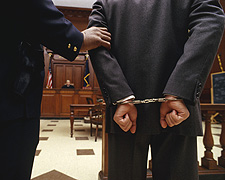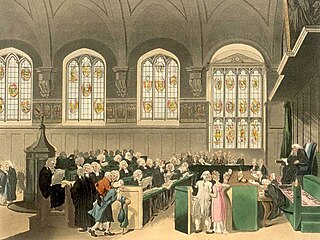Related Research Articles

United States appellate procedure involves the rules and regulations for filing appeals in state courts and federal courts. The nature of an appeal can vary greatly depending on the type of case and the rules of the court in the jurisdiction where the case was prosecuted. There are many types of standard of review for appeals, such as de novo and abuse of discretion. However, most appeals begin when a party files a petition for review to a higher court for the purpose of overturning the lower court's decision.

In court proceedings, a defendant is a person or object who is the party either accused of committing a crime in criminal prosecution or against whom some type of civil relief is being sought in a civil case.
A statute of limitations, known in civil law systems as a prescriptive period, is a law passed by a legislative body to set the maximum time after an event within which legal proceedings may be initiated. In most jurisdictions, such periods exist for both criminal law and civil law such as contract law and property law, though often under different names and with varying details.

A summary offence or petty offence is a violation in some common law jurisdictions that can be proceeded against summarily, without the right to a jury trial and/or indictment.
Equity is a particular body of law that was developed in the English Court of Chancery. Its general purpose is to provide a remedy for situations where the law is not flexible enough for the usual court system to deliver a fair resolution to a case. The concept of equity is deeply intertwined with its historical origins in the common law system used in England. However, equity is in some ways a separate system from common law: it has its own established rules and principles, and was historically administered by separate courts, called "courts of equity" or "courts of chancery".
In the United States, a state court has jurisdiction over disputes with some connection to a U.S. state. State courts handle the vast majority of civil and criminal cases in the United States; the United States federal courts are far smaller in terms of both personnel and caseload, and handle different types of cases.

Maxims of equity are legal maxims that serve as a set of general principles or rules which are said to govern the way in which equity operates. They tend to illustrate the qualities of equity, in contrast to the common law, as a more flexible, responsive approach to the needs of the individual, inclined to take into account the parties' conduct and worthiness. They were developed by the English Court of Chancery and other courts that administer equity jurisdiction, including the law of trusts. Although the most fundamental and time honored of the maxims, listed on this page, are often referred to on their own as the 'maxims of equity' or 'the equitable maxims',The first equitable maxim is 'equity delights in equality' or equity is equality Like other kinds of legal maxims or principles, they were originally, and sometimes still are, expressed in Latin.
A summons is a legal document issued by a court or by an administrative agency of government for various purposes.

A traffic ticket is a notice issued by a law enforcement official to a motorist or other road user, indicating that the user has violated traffic laws. Traffic tickets generally come in two forms, citing a moving violation, such as exceeding the speed limit, or a non-moving violation, such as a parking violation, with the ticket also being referred to as a parking citation, or parking ticket.
A civil penalty or civil fine is a financial penalty imposed by a government agency as restitution for wrongdoing. The wrongdoing is typically defined by a codification of legislation, regulations, and decrees. The civil fine is not considered to be a criminal punishment, because it is primarily sought in order to compensate the state for harm done to it, rather than to punish the wrongful conduct. As such, a civil penalty, in itself, will not carry jail time or other legal penalties. For example, if a person were to dump toxic waste in a state park, the state would have the same right to seek to recover the cost of cleaning up the mess as would a private landowner, and to bring the complaint to a court of law, if necessary.
Section 11 of the Canadian Charter of Rights and Freedoms is the section of the Canadian Constitution that protects a person's legal rights in criminal and penal matters. There are nine enumerated rights protected in section 11.
In re Debs, 158 U.S. 564 (1895), was a US labor law case of the United States Supreme Court decision handed down concerning Eugene V. Debs and labor unions.

Asset forfeiture or asset seizure is a form of confiscation of assets by the authorities. In the United States, it is a type of criminal-justice financial obligation. It typically applies to the alleged proceeds or instruments of crime. This applies, but is not limited, to terrorist activities, drug-related crimes, and other criminal and even civil offenses. Some jurisdictions specifically use the term "confiscation" instead of forfeiture. The alleged purpose of asset forfeiture is to disrupt criminal activity by confiscating assets that potentially could have been beneficial to the individual or organization.

Most seat belt laws in the United States are left to the states and territories. However, the first seat belt law was a federal law, Title 49 of the United States Code, Chapter 301, Motor Safety Standard, which took effect on January 1, 1968, that required all vehicles to be fitted with seat belts in all designated seating positions. This law has since been modified to require three-point seat belts in outboard-seating positions, and finally three-point seat belts in all seating positions. Seat belt use was voluntary until New York became the first state to require vehicle occupants to wear seat belts, as of December 1, 1984. New Hampshire is the only state that has no enforceable laws requiring adults to wear seat belts in a vehicle.

The Judiciary of New York is the judicial branch of the Government of New York, comprising all the courts of the State of New York.
Criminal law is the body of law that relates to crime. It prescribes conduct perceived as threatening, harmful, or otherwise endangering to the property, health, safety, and welfare of people inclusive of one's self. Most criminal law is established by statute, which is to say that the laws are enacted by a legislature. Criminal law includes the punishment and rehabilitation of people who violate such laws.
A citizen’s right to a trial by jury is a central feature of the United States Constitution. It is considered a fundamental principle of the American legal system.
The Judiciary of New Jersey comprises the New Jersey Supreme Court as the state supreme court and many lower courts.
Pasqua v. Council, 892 A.2d 663 was a landmark family court decision decided by the Supreme Court of New Jersey in 2006. The court ruled that indigent parents facing the serious threat of incarceration for nonpayment of child support were entitled to legal counsel.
In re Oliver, 333 U.S. 257 (1948), was a decision by the United States Supreme Court involving the application of the right of due process in state court proceedings. The Sixth Amendment in the Bill of Rights states that criminal prosecutions require the defendant "... to be informed of the nature and cause of the accusation...and to have the Assistance of Counsel for his defence." In this case, a witness in a Michigan grand jury hearing was convicted and sentenced to jail without either notice or attorney assistance.
References
- 1 2 3 4 5 Hill, Gerald N.; Hill, Kathleen (2002). The people's law dictionary : taking the mystery out of legal language. New York, NY: MJF Books. ISBN 9781567315530.
- ↑ See also Quasimodo.
- ↑ N.Y. Jur. 2d, Words and Phrases, Quasi.
- ↑ Ballentine's Law Dictionary, p. 450
- 1 2 3 4 Quasi criminal rights of persons charged with Motor vehicle offenses including DWI and Driving While Suspended Archived June 9, 2007, at the Wayback Machine , citing State v. Cooper, 129 N.J. Super. 229, 231 (App. Div.), certif. denied, 66 N.J. 329 (1974); State v. Selzer, 57 N.J. Super. 327, 330 (Law Div. 1959); State v. Rowe, 116 N.J.L. 48, 51 (1935); Vickey v. Nessler, 230 N.J. Super. 141, 149 (1989); amongst other cases.
- ↑ Illinois law
- ↑ N.Y. Penal law, § 10.00, which uses the termm "offense", found at , go to "PEN", article 10.
- 1 2 Rules of the Cook County Circult Court, Illinois Website Archived May 17, 2008, at the Wayback Machine . Accessed June 30, 2008.
- ↑ Montaldo, Charles Quasi-criminal on the About.com Website. Accessed June 30, 2008.
- ↑ David L. Ratley, Judicial Council of Georgia, Administrative Office of the Courts, Memorandum, Zoning & Traffic Fine Questions as applied to POABF, December 18, 2003, found at Georgia Courts Memo on Application of Quasi-criminal Archived July 28, 2007, at the Wayback Machine . Accessed June 30, 2008.
- ↑ New York Mental Hygiene law, article 81.